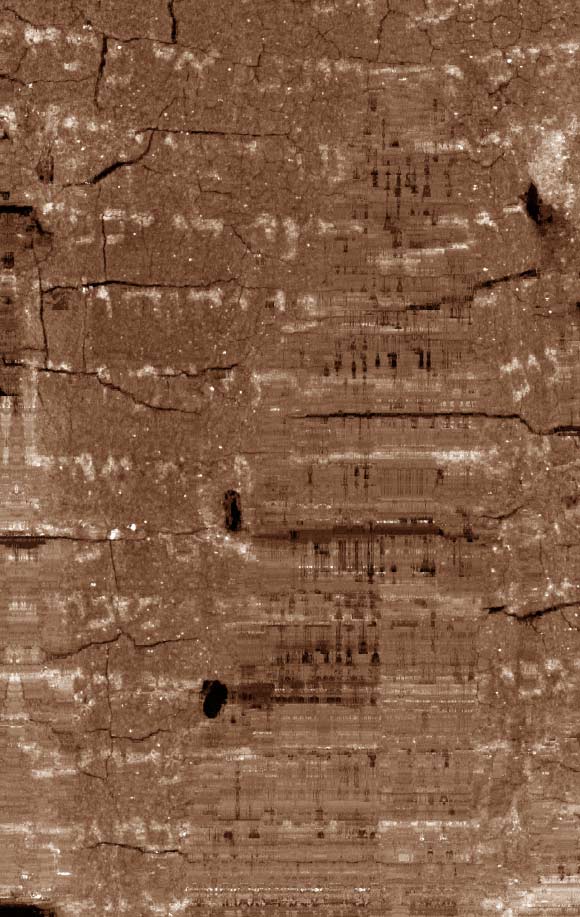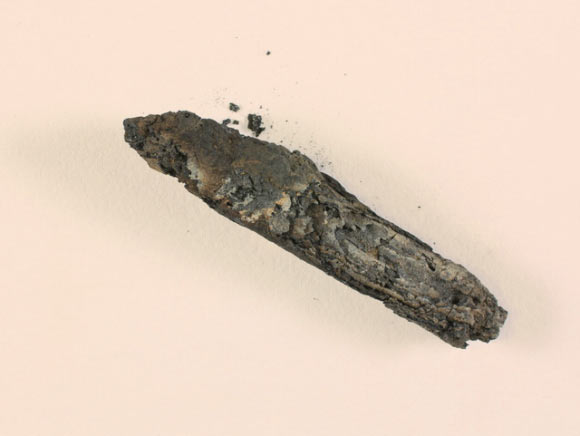A burned 1,500-year-old scroll found at Ein Gedi, on the western shore of the Dead Sea, has been read using advanced digital imaging.

Unwrapped texture image of the Ein Gedi scroll, showing letters of the Hebrew alphabet. Image credit: Seth Parker / University of Kentucky.
The scroll was discovered in 1970 inside the Holy Ark of the synagogue at Ein Gedi, Israel. However, due to its charred condition, it was not possible to either preserve or decipher it.
It turns out that part of this scroll is from the beginning of the Book of Leviticus, written in Hebrew, and dated by a carbon-14 analysis to the 6th century CE.
To date, this is the most ancient scroll from the five books of the Hebrew Bible to be found since the Dead Sea scrolls, most of which are ascribed to the end of the Second Temple period (1st century BC – 1st century CE).
The Ein Gedi scroll was scanned with a micro-computed tomography machine. The scanning process is X-ray-based and completely non-invasive as the scroll is badly damaged from fire and cannot be physically opened.
The scans were done in Israel with assistance from Merkel Technologies Company Ltd. and the Israel Antiquities Authority (IAA).
The IAA scientists then sent the scans to Prof Brent Seales from the University of Kentucky, who developed a software prototype which allows to ‘virtually unroll’ scrolls and visualize text.
“This unwrapping process allows the visualization of evidence of writing on a surface from within a scanned volume,” Prof Seales explained.
“I have been using the word ‘surface’ to refer to the page of biblical text we have revealed. But this is a term of geometry, not of precise position.”
“The page actually comes from a layer buried deep within the many wraps of the scroll body, and is possible to view it only through the remarkable results of our software, which implements the research idea of virtual unwrapping.”
Thus, the great surprise and excitement when the first eight verses of the Book of Leviticus suddenly became legible:
“The Lord summoned Moses and spoke to him from the tent of meeting, saying: Speak to the people of Israel and say to them: When any of you bring an offering of livestock to the Lord, you shall bring your offering from the herd or from the flock.
If the offering is a burnt-offering from the herd, you shall offer a male without blemish; you shall bring it to the entrance of the tent of meeting, for acceptance in your behalf before the Lord.
You shall lay your hand on the head of the burnt-offering, and it shall be acceptable in your behalf as atonement for you.
The bull shall be slaughtered before the Lord; and Aaron’s sons the priests shall offer the blood, dashing the blood against all sides of the altar that is at the entrance of the tent of meeting. The burnt-offering shall be flayed and cut up into its parts.
The sons of the priest Aaron shall put fire on the altar and arrange wood on the fire.
Aaron’s sons the priests shall arrange the parts, with the head and the suet, on the wood that is on the fire on the altar (Leviticus 1:1-8).”
“The deciphering of the scroll, which was a puzzle for us for 45 years, is very exciting,” said IAA archaeologist Dr Sefi Porath, discoverer of the Ein Gedi scroll.
“Ein Gedi was a Jewish village in the Byzantine period (4th – 7th century CE) and had a synagogue with an exquisite mosaic floor and a Holy Ark. The settlement was completely burnt to the ground, and none of its inhabitants ever returned to reside there again, or to pick through the ruins in order to salvage valuable property.”
“In the archaeological excavations of the burnt synagogue, we found in addition to the charred scroll fragments, a bronze seven-branched candelabrum (menorah), the community’s money box containing around 3,500 coins, glass and ceramic oil lamps, and vessels that held perfume.”
“We have no information regarding the cause of the fire, but speculation about the destruction ranges from Bedouin raiders from the region east of the Dead Sea to conflicts with the Byzantine government.”








